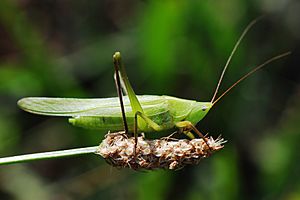Nsenene facts for kids
Quick facts for kids Nsenene |
|
|---|---|
 |
|
| Nsenene look-alike (Ruspolia nitidula) | |
| Scientific classification | |
| Genus: |
Ruspolia
|
| Species: |
differens
|
| Synonyms | |
|
|
Nsenene is the Luganda name for a type of bush cricket called Ruspolia differens. Bush crickets are also known as katydids. They are sometimes mistakenly called "long-horned grasshoppers" because they look a bit like grasshoppers but have much longer antennae.
Contents
Nsenene: A Special Bush Cricket
Nsenene are a specific kind of bush cricket. They belong to a group known as 'cone-heads' because of the shape of their heads. These insects are well-known in parts of Africa, especially for their role in local culture and food.
Where Nsenene Live
Nsenene are found in several countries in Africa. You can find them in Uganda, Kenya, Rwanda, Tanzania, and even on the island of Madagascar. In Uganda, they are especially common in the central and southwestern areas.
Nsenene as Food
In many parts of Uganda, nsenene are considered a special food. They are a popular delicacy, which means they are a rare and tasty treat. Eating insects, also known as entomophagy, is common in many cultures around the world. Nsenene are also an important way for people to earn money in these regions.
Traditional Beliefs and Changes
For a long time, nsenene have been important in the Buganda Kingdom of Uganda. They are even seen as a special symbol or "totem" for some groups of people.
Traditionally, in Uganda, children and women would collect nsenene. This was often hard work. The collected insects were then given to the women's husbands. In return, the women would sometimes receive a new gomasi, which is a traditional dress.
In the past, there were old beliefs that prevented women from eating nsenene. However, these beliefs have changed a lot over time. Today, most women in the areas where nsenene are eaten also enjoy them as food.

